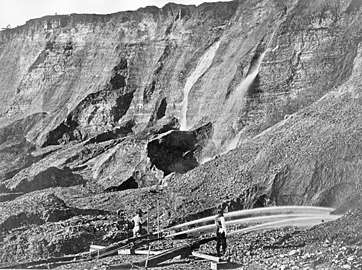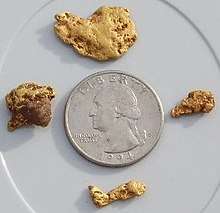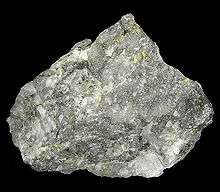Gold extraction
Gold extraction refers to the processes required to extract gold from its ores. This may require a combination of comminution, mineral processing, hydrometallurgical, and pyrometallurgical processes to be performed on the ore.[1]

Gold mining from alluvium ores was once achieved by techniques associated with placer mining such as simple gold panning and sluicing, resulting in direct recovery of small gold nuggets and flakes. Placer mining techniques since the mid to late 20th century have generally only been the practice of artisan miners. Hydraulic mining was used widely in the Californian gold rush, and involved breaking down alluvial deposits with high-pressure jets of water. Hard rock ores have formed the basis of the majority of commercial gold recovery operations since the middle of the 20th century where open pit and or sub-surface mining techniques are used.
Once the ore is mined it can be treated as a whole ore using a dump leaching or heap leaching processes. This is typical of low-grade, oxide deposits. Normally, the ore is crushed and agglomerated prior to heap leaching. High grade ores and ores resistant to cyanide leaching at coarse particle sizes, require further processing in order to recover the gold values. The processing techniques can include grinding, concentration, roasting, and pressure oxidation prior to cyanidation.
History
The smelting of gold began sometime around 6000 - 3000 BC.[2][3][4] According to one source the technique began to be in use in Mesopotamia or Syria.[5] In ancient Greece, Heraclitus wrote on the subject.[6]
According to de Lecerda and Salomons (1997) mercury was first in use for extraction at about 1000 BC,[7] according to Meech and others (1998), mercury was used in obtaining gold until the latter period of the first millennia.[8][9][10][11]
A technique known to Pliny the Elder was extraction by way of crushing, washing, and then applying heat, with the resultant material powdered.[12][13][14]
Industrial era

The solubility of gold in a water and cyanide solution was discovered in 1783 by Carl Wilhelm Scheele, but it was not until the late 19th century, that an industrial process was developed. The expansion of gold mining in the Rand of South Africa began to slow down in the 1880s, as the new deposits being found tended to be pyritic ore. The gold could not be extracted from this compound with any of the then available chemical processes or technologies.
In 1887, John Stewart MacArthur, working in collaboration with brothers Dr Robert and Dr William Forrest for the Tennant Company in Glasgow, Scotland, developed the MacArthur-Forrest Process for the extraction of gold ores. By suspending the crushed ore in a cyanide solution, a separation of up to 96 percent pure gold was achieved.[15] [16][17][18][19][20][21]
The process was first used on a large scale at the Witwatersrand in 1890, leading to a boom of investment as larger gold mines were opened up. In 1896, Bodländer confirmed that oxygen was necessary for the process, something that had been doubted by MacArthur, and discovered that hydrogen peroxide was formed as an intermediate.[22]
The method known as heap leaching was first proposed in 1969 by the United States Bureau of Mines,[23] and was in use by the 1970s.[24]
Types of ore
Gold occurs principally as a native metal, usually alloyed to a greater or lesser extent with silver (as electrum), or sometimes with mercury (as an amalgam). Native gold can occur as sizeable nuggets, as fine grains or flakes in alluvial deposits, or as grains or microscopic particles (known as color) embedded in rock minerals.
Ores in which gold occurs in chemical composition with other elements are comparatively rare. They include calaverite, sylvanite, nagyagite, petzite and krennerite.
Concentration

Gravity concentration has been historically the most important way of extracting the native metal using pans or washing tables. Amalgamation with mercury was used to enhance recovery, often by adding it directly to the riffle tables, and mercury is still widely used in small diggings across the world. However, froth flotation processes may also be used to concentrate the gold. In some cases, particularly when the gold is present in the ore as discrete coarse particles, a gravity concentrate can be directly smelted to form gold bars. In other cases, particularly when the gold is present in the ore as fine particles or is not sufficiently liberated from the host rock, the concentrates are treated with cyanide salts, a process known as cyanidation leaching, followed by recovery from the leach solution. Recovery from solution typically involves adsorption on activated carbon then stripping (eluting) the gold from the carbon and passing the pregnant solution through electrowinning and then onto the smelting process.
Froth flotation is usually applied when the gold present in an ore is closely associated with sulfide minerals such as pyrite, chalcopyrite or arsenopyrite, and when such sulfides are present in large quantities in the ore. In this case, concentration of the sulfides results in concentration of gold values. Generally, recovery of the gold from the sulfide concentrates requires further processing, usually by roasting or wet pressure oxidation. These pyrometallurgical or hydrometallurgical treatments are themselves usually followed by cyanidation and carbon adsorption techniques for final recovery of the gold.
Sometimes gold is present as a minor constituent in a base metal (e.g. copper) concentrate, and is recovered as a by-product during production of the base metal. For example, it can be recovered in the anode slime during the electrorefining process.
The results of laboratory and bench experimental studies can be used with sufficient accuracy to implement adhesive gold dressing of fine and nano-size particles within a “few hundred microns – a few tens of nanometers”.[25]
Leaching
If the gold can not be concentrated for smelting, then it is leached by an aqueous solution:
- The cyanide process is the industry standard.
- Thiosulfate leaching has been proven to be effective on ores with high soluble copper values or ores which experience preg-robbing: the absorption by carbonaceous components which preferentially absorbs gold and gold-cyanide complexes.
Leaching through Bulk Leach Extractable Gold, or BLEG, is also a process that is used to test an area for gold concentrations where gold may not be immediately visible.
Refractory gold processes

A "refractory" gold ore is an ore that has ultra fine gold particles disseminated throughout its gold occluded minerals. These ores are naturally resistant to recovery by standard cyanidation and carbon adsorption processes. These refractory ores require pre-treatment in order for cyanidation to be effective in recovery of the gold. A refractory ore generally contains sulfide minerals, organic carbon, or both. Sulfide minerals are impermeable minerals that occlude gold particles, making it difficult for the leach solution to form a complex with the gold. Organic carbon present in gold ore may adsorb dissolved gold-cyanide complexes in much the same way as activated carbon. This so-called "preg-robbing" carbon is washed away because it is significantly finer than the carbon recovery screens typically used to recover activated carbon.
Pre-treatment options for refractory ores include:
- Roasting
- Bio-oxidation, such as Bacterial oxidation
- Pressure oxidation
- Albion process
The refractory ore treatment processes may be preceded by concentration (usually sulfide flotation). Roasting is used to oxidize both the sulfur and organic carbon at high temperatures using air and/or oxygen. Bio-oxidation involves the use of bacteria that promote oxidation reactions in an aqueous environment. Pressure oxidation is an aqueous process for sulfur removal carried out in a continuous autoclave, operating at high pressures and somewhat elevated temperatures. The Albion process utilises a combination of ultrafine grinding and atmospheric, auto-thermal, oxidative leaching.
Gold smelting
Mercury removal
Mercury is a health hazard, especially when in gas form. To remove this hazard, before smelting, gold precipitates from electrowinning or Merrill-Crowe processes are usually heated in a retort to recover any mercury present, that would otherwise cause health and environmental problems due to its release (volatilization) during smelting. The mercury present is not usually from the mercury amalgamation process that is no longer used by formal gold mining companies, but from mercury in the ore that has followed gold through the leaching and precipitation processes.
In the event that there are high levels of copper present, leaching of the precipitate using nitric or sulfuric acids may be required.
Iron removal
Nitric acid or forced air oven oxidation can also be used to dissolve iron from the electrowinning cathodes before smelting. Gravity concentrates can often contain high grinding steel contents, and so their removal using shaking tables or magnets is used before smelting. During smelting iron can be oxidized using nitre. Excessive use of nitre will corrode the smelting pot, increasing both maintenance costs and the risk of catastrophic leaks (known as run-aways, or holes in the pot through which the molten charge is lost). Magnetic separation is also very effective for separating iron impurities.
Gold refining and parting
Gold parting is primarily the removing of silver from gold and therefore increasing the purity of gold. The parting of gold from silver has been done since ancient times starting in Lydia in the 6th century BC. Various techniques have been practised; salt cementation from ancient times, parting using distilled mineral acids from medieval times, and in modern times using chlorination using the Miller process and electrolysis using the Wohlwill process.
See also
- Digger gold
- Gold mining
- Ore genesis
- Bulk leach extractable gold
References
- "Gold Extraction - Gold Mining - Washing, Amalgamation, Leaching, Smelting". geology.com. Archived from the original on 2013-08-16. Retrieved 2008-03-20.
- Gold Field Mineral Services (GFMS)-(goldavenue.com) & I Podleska and T Green - goldavenue Archived 2002-04-01 at the Wayback Machine Retrieved 2012-07-01
- Carnegie Mellon University Dept. of Material Science and Engineering - "Archived copy". Archived from the original on 2008-12-11. Retrieved 2008-09-12.CS1 maint: archived copy as title (link) Retrieved 2012-07-01
- G Leick - Historical Dictionary of Mesopotamia Scarecrow Press, 16 Dec 2009 Retrieved 2012-07-01 ISBN 0810863243
- R.J. Forbes - Studies in Ancient Technology, Volume 1 Brill Archive, 1993 Retrieved 2012-07-01
- M Y Treister - The Role of Metals in Ancient Greek History BRILL, 1996 Retrieved 2012-07-01 ISBN 9004104739
- B Lottermoser - Mine Wastes: Characterization, Treatment and Environmental Impacts Springer, 2 Aug 2010 Retrieved 2012-07-22 ISBN 3642124186
- R Eisler - Mercury Hazards to Living Organisms CRC Press, 14 Mar 2006 Retrieved 2012-07-21 ISBN 0849392128
- (secondary)L Drude De Lacerda, W Salomons - Mercury from Gold and Silver Mining: A Chemical Time Bomb? Springer, 1998 Retrieved 2012-07-21 ISBN 3540617248
- (secondary) Guido Küstel - Nevada and California processes of silver and gold extraction F. D. Carlton, 1863 Retrieved 2012-07-21
- (secondary) A Tilloch - Philosophical Magazine, Volume 52 Retrieved 2012-07-21
- JM Stillman - Story of Alchemy and Early Chemistry Kessinger Publishing, 1 Jan 2003 Retrieved 2012-07-22
- (primary source "Pliny") S Venable - Gold: A Cultural Encyclopedia ABC-CLIO, 2011 Retrieved 2012-07-22 ISBN 0313384312
- (secondary) M Page - The First Global Village: How Portugal Changed the World Leya, 2006 Retrieved 2012-07-22 ISBN 9724613135
- "Methods to recover Gold II".
- L Gmelin -Hand book of chemistry, Volume 8 Printed for the Cavendish Society, 1853 Retrieved 2012-07-21
- RG Bautista (TB Drew). Advances in Chemical Engineering, Volume 9. Academic Press, 1974. ISBN 0120085097. Retrieved 2012-07-21.
- WH Brock - William Crookes (1832-1919) and the Commercialization of Science Ashgate Publishing, Ltd., 2008 Retrieved 2012-07-17 ISBN 0754663221
- R Eisler - Eisler's Encyclopedia of Environmentally Hazardous Priority Chemicals Elsevier, 8 Aug 2007 Retrieved 2012-07-17 ISBN 044453105X
- J Park - The Cyanide Process of Gold Extraction C. Griffin, limited, 1820 Retrieved 2012-07-17
- J Marsden, I House. The Chemistry of Gold Extraction. SME, 5 Jun 2006. ISBN 0873352408. Retrieved 2012-07-17.
- Habashi, Fathi Recent Advances in Gold Metallurgy Archived 2008-03-30 at the Wayback Machine
- R Eisler (sourced originally in Marsden and House)
- GW Ware - Reviews of Environmental Contamination and Toxicology Springer, 15 Jul 2004 Retrieved 2012-07-17 ISBN 0387208445
- Biletskyi, V. (2016). Research into adhesive ore-dressing technologies of fine- and nano gold. Mining of Mineral Deposits, 10(4), 19-28.https://doi.org/10.1540 7/mining10.04.019